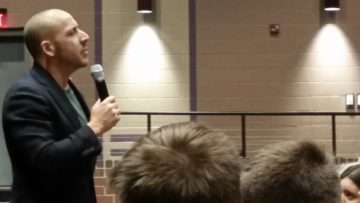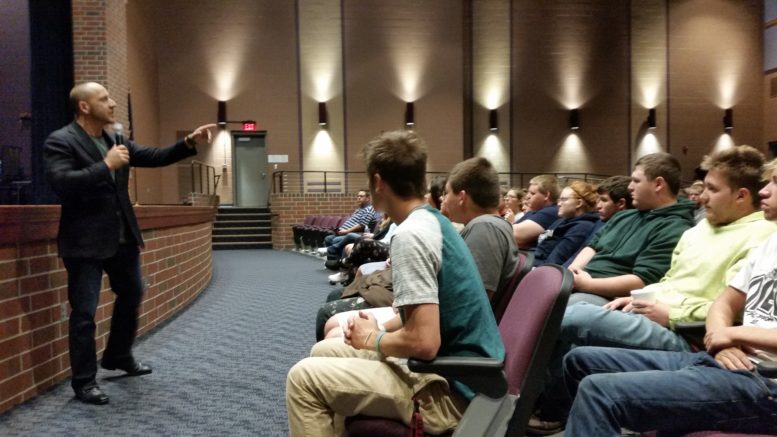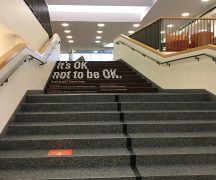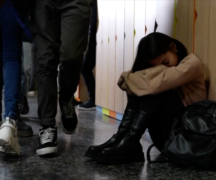By JAN LARSON McLAUGHLIN
BG Independent News
The second that Kevin Hines cleared the railing on the Golden Gate Bridge, he knew he had made a mistake. But by then, he was falling 220 feet at 75 mph.
Up until that moment, Hines believed he had to kill himself.
Hines spoke Tuesday morning to an auditorium full of Otsego High School students. Next month, he will talk with students at Bowling Green City Schools. He was asked to speak at local schools after the recent Wood County youth survey showed an increase in suicide ideation among 7th through 11th graders. In fact, the local rates were higher than the state and national averages.
Hines told students they should not keep quiet about their pain.
“I was falling apart at the seams, but I hid it from everybody,” he told the students. “Your pain is valid. Your pain matters, because you matter.”
Hines was first diagnosed with bipolar disorder and paranoia during his junior year of high school. The diagnosis came after he had a role in the play “How to Succeed in Business Without Really Trying.”
“I was on a stage, much like this,” he told the students, pointing to their auditorium stage. When Hines looked out at the audience of 1,200 people, he was certain they were all there to kill him. He ran off the stage.
Hines went to a psychiatrist, who started treating him. But Hines was resistant. “I didn’t want to be there. I didn’t want something to be wrong with me.”
Before long, the active, athletic teen was withdrawn, depressed and having hallucinations.
After graduating, Hines enrolled in community college. But he missed many days since he had to be on the watch for postal service workers, who he believed to be assassins.
But Hines knew enough to not tell his family about the assassins in white mail trucks, or that he frequently spent his nights talking to “Death.” He didn’t want his parents to think he was crazy.
“So I buried it, and I silenced my pain.”

Suicide attempt survivor Kevin Hines
But on Sept. 24, 2000, at age 19, Hines could not stand it anymore.
“I found myself sitting at my desk in my room, writing a note.” He said goodbye to his dad, mom, brother, sister, and to his best friend, who he advised to get a new best friend.
At 6 a.m., Hines walked into his dad’s bedroom to say that he loved him. All the while, the voices in his head were telling him he had to die.
“I didn’t know my thoughts didn’t have to become my actions,” he said. “I thought I was a burden to everyone.”
His dad seemed to sense something was wrong, and asked Hines to go to work with him that day. Hines reassured him that everything was fine.
But before long, Hines was on a bus headed for the Golden Gate Bridge. He remembers yelling to himself, “I don’t want to die. Why do you hate me so much?” He wanted someone to intervene, but the other passengers reacted with fear and apathy.
“They were there to create happy memories. I was there to delete all of mine,” he said.
“I desperately wanted to live, while my brain was trying to kill me.”
Hines was the last passenger off the bus. With tears streaming down his face, he remembered hoping that the bus driver would ask if he could help. Instead, the driver said, “Come on kid, get off the bus. I’ve got to go.”
A woman did approach Hines on the bridge – and he thought she would ask him if he was OK.
“Those are the only words I wanted to hear as I stood at the top of the Golden Gate Bridge walkway.”
But instead, she asked him to take her photo on the bridge. He did.
Then he sprinted a short distance and cleared the railing, starting his 25-story fall. He instantly felt regret.
The impact on the water was like hitting a solid, shattering his spine. He went under an estimated 70 feet, then swam frantically to the surface. In that moment, Hines became number 26 of the 36 people who have survived a jump from that bridge. There’s an average of one jump a week by someone attempting suicide.
“They call it the most exclusive survivors group in the world,” he said.
The Coast Guard rescued him from the water and reunited with his family. Hines spent months in a hospital, recovering from his physical wounds. But that was just the beginning of his recovery process. He was then placed in a psychiatric ward, and after eight years, he found the medication that works for him. He eats right, exercises, has developed coping strategies, and refrains from alcohol and illegal drugs.
“I’ve been given 17 years past the day I should have died,” Hines said. “I’m grateful for everything I get to do.”
His advice to the students was simple. “Never again silence your pain. You deserve to be heard.”
Hines told them not to shy away from the topic of suicide. Asking someone if they are thinking about suicide does not put the idea in their head, he explained.
At the end of his program, Hines asked the students to stand and look at the ceiling, so they weren’t yelling into someone’s ear. He asked them to shout, “Be here tomorrow.”
“Blow the roof off this joint,” he said.
The students complied, letting loose with a thunderous “Be here tomorrow” to their fellow students, then gave Hines a standing ovation.
Hines was brought to Wood County by Project AWARE Ohio, the Wood County Educational Service Center, and the Wood County Suicide Prevention Coalition.
Hines travels the world talking to students, the military, clergy, clinicians, law enforcement, business, and industry about the complex conditions that contribute to mental illness and how to cope, seek support, and maintain hope. He has earned numerous awards for his work and sits on boards including the International Bi-Polar Foundation, the Bridge Rail Foundation, and the Survivors Committee of the National Suicide Prevention Lifeline. In 2013, he released his memoir “Cracked Not Broken: Surviving and Thriving after a Suicide Attempt.”





